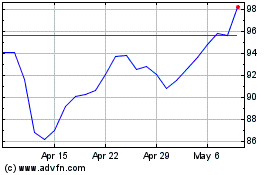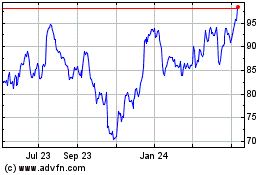Morgan Stanley Hit Hardest in Bank Selloff
09 February 2016 - 11:53AM
Dow Jones News
By Ben Eisen and Justin Baer
Morgan Stanley got hit hard Monday.
On a day when the six largest U.S. banks all dropped more than
the broader market, Morgan Stanley's shares took the worst beating.
The lender was down 6.9% as the S&P 500 dropped 1.4%. Since the
start of the year, Morgan Stanley shares are down 29%.
Here are a few factors that may have contributed to the
selloff:
-- Low returns. The Wall Street firm, which remains short of its goal of
producing a return on equity of at least 10%, is overhauling a
fixed-income trading business whose choppy results have frustrated
executives and investors alike. Morgan Stanley has installed new managers
and slashed its workforce.
On Tuesday, its head of trading will deliver what shareholders
hope will be a clear roadmap to higher returns at Credit Suisse
Group AG's financials conference.
Monday's sell-off, however, may mean those hopes have faded.
-- Globe trotting troubles. Monday's drop came as Deutsche Bank AG shares
fell 9.5% and other European banks declined sharply.
Morgan Stanley has long been considered by many as having more
international exposure than most of its U.S.-based peers, so shares
are affected by market action abroad. Its shares tended to react
sharply to both positive and negative news about the European debt
crisis in 2011 and 2012.
Though the perception that Morgan Stanley has disproportionate
overseas exposure isn't necessarily accurate, the market sentiment
has been, "the more international the name, the more the downside,"
said Jeffery Harte, an analyst at Sandler O'Neill + Partners.
Citigroup Inc., also seen as having a large exposure to global
markets, was down 5.1% Monday.
-- Small enough to stumble. The bank's market value of $44 billion makes it
the smallest of the six major banks. So it could be seen as having the
least resiliency to global economic turbulence, including concerns over
economic growth, interest rates and loan losses tied to an energy
industry pummeled by falling commodity prices.
Still, there is no perception that Morgan Stanley faces any
existential threat. "It's big enough not to have survivorship kind
of fears" Mr. Harte said.
-- The higher they fly, the harder they fall. Morgan SHItanley's stock had
a big run-up through the middle of last year as the bank was expected to
benefit from refocusing the business on its retail brokerage. Shares
climbed 58% during the two years through June, compared with 25% during
the same period for the KBW Nasdaq Bank Index. When bank stocks sold off,
Morgan Stanley's shares were hit more, sliding 42% since the beginning of
July, compared with the benchmark's 24%.
The financial sector sell-off has also hit bond investors. The
premium over U.S. Treasurys that investors demanded to be paid on
10-year Morgan Stanley bonds rose 0.15 percentage points on Monday
to 2.02 percentage points, according to MarketAxess.
Since the beginning of the year, the annual cost of insuring
debt for the six biggest U.S. banks using five-year credit default
swaps rose by about a third on average to 1%, according to Anthony
Valeri, investment strategist at LPL Financial. Even still, this is
far below levels seen in 2008 or 2012.
"It's built into a little bit of a frenzy here. It has knocked
down stock prices, but also more on the credit side," said Lon
Erickson, who manages $5.3 billion at Thornburg Investment
Management. "In general banks and financials have always been a
little bit more of a black box situation when you're trying to
analyze."
(END) Dow Jones Newswires
February 08, 2016 19:38 ET (00:38 GMT)
Copyright (c) 2016 Dow Jones & Company, Inc.
Morgan Stanley (NYSE:MS)
Historical Stock Chart
From Mar 2024 to Apr 2024

Morgan Stanley (NYSE:MS)
Historical Stock Chart
From Apr 2023 to Apr 2024
